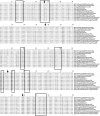Evaluation of rabies biologics against Irkut virus isolated in China
- PMID: 23946522
- PMCID: PMC3889725
- DOI: 10.1128/JCM.01565-13
Evaluation of rabies biologics against Irkut virus isolated in China
Abstract
An Irkut virus (IRKV) was recently isolated from a bat in China. The protective ability of rabies biologics available in the Chinese market and experimental biologics against the rabies virus (RABV) and IRKV were assessed in a hamster model via preexposure prophylaxis (PrEP) and postexposure prophylaxis (PEP) experiments. The results demonstrated that a single dose of rabies vaccine did not induce adequate protection against IRKV infection. However, routine PrEP with three doses of vaccine induced complete protection against IRKV infection. Higher doses of RABV immunoglobulins and alpha interferon were required during PEP to protect hamsters against IRKV versus RABV infection. Experimental recombinant vaccines containing IRKV glycoproteins induced more-reliable protection against IRKV than against RABV infection. Those findings may be explained by limited cross-neutralization of these viruses (confirmed via in vitro tests) in conjunction with antigenic distances between RABV and IRKV. These results indicate that the development and evaluation of new biologics for PrEP and PEP are required to ensure sufficient protection against IRKV infection in China and other territories where this virus is present.
Figures

Similar articles
-
Toward the Development of a Pan-Lyssavirus Vaccine.Viruses. 2024 Jul 10;16(7):1107. doi: 10.3390/v16071107. Viruses. 2024. PMID: 39066269 Free PMC article.
-
Efficacy of rabies biologics against new lyssaviruses from Eurasia.Virus Res. 2005 Jul;111(1):44-54. doi: 10.1016/j.virusres.2005.03.009. Epub 2005 Apr 26. Virus Res. 2005. PMID: 15896401
-
Possible Transmission of Irkut Virus from Dogs to Humans.Biomed Environ Sci. 2018 Feb;31(2):146-148. doi: 10.3967/bes2018.017. Biomed Environ Sci. 2018. PMID: 29606193
-
Emerging tropical diseases in Australia. Part 3. Australian bat lyssavirus.Ann Trop Med Parasitol. 2010 Dec;104(8):613-21. doi: 10.1179/136485910X12851868779948. Ann Trop Med Parasitol. 2010. PMID: 21144181 Review.
-
Veterinary surgeon's guide to Australian bat lyssavirus.Aust Vet J. 1999 Nov;77(11):710-2. doi: 10.1111/j.1751-0813.1999.tb12904.x. Aust Vet J. 1999. PMID: 10685161 Review.
Cited by
-
Immunogenicity, Efficacy and Twelve-Month Storage Stability Studies of a Lyophilized Rabies mRNA Vaccine.Vaccines (Basel). 2025 Jul 10;13(7):743. doi: 10.3390/vaccines13070743. Vaccines (Basel). 2025. PMID: 40733720 Free PMC article.
-
Epidemiology of Animal Rabies - China, 2010-2020.China CDC Wkly. 2021 Sep 24;3(39):815-818. doi: 10.46234/ccdcw2021.202. China CDC Wkly. 2021. PMID: 34594998 Free PMC article.
-
Renewed Public Health Threat from Emerging Lyssaviruses.Viruses. 2021 Sep 4;13(9):1769. doi: 10.3390/v13091769. Viruses. 2021. PMID: 34578350 Free PMC article.
-
Neglected challenges in the control of animal rabies in China.One Health. 2021 Jan 5;12:100212. doi: 10.1016/j.onehlt.2021.100212. eCollection 2021 Jun. One Health. 2021. PMID: 33553562 Free PMC article. Review.
-
Cross-neutralization of antibodies induced by vaccination with Purified Chick Embryo Cell Vaccine (PCECV) against different Lyssavirus species.Hum Vaccin Immunother. 2014;10(10):2799-804. doi: 10.4161/21645515.2014.972741. Hum Vaccin Immunother. 2014. PMID: 25483634 Free PMC article.
References
-
- Kuzmin IV, Tordo N. 2012. Genus lyssavirus, p 37–57 In Dietzgen RD, Kuzmin IV. (ed), Rhabdoviruses: molecular taxonomy, evolution, genomics, ecology, host-vector interactions, cytopathology and control. Caister Academic Press, London, United Kingdom
-
- Hu RL, Tang Q, Tang JR, Fooks AR. 2009. Rabies in China: an update. Vector Borne Zoonotic Dis. 9:1–12 - PubMed
Publication types
MeSH terms
Substances
LinkOut - more resources
Full Text Sources
Other Literature Sources
Medical
Miscellaneous

